1993 CHEVROLET S10 ESP
[x] Cancel search: ESPPage 191 of 356
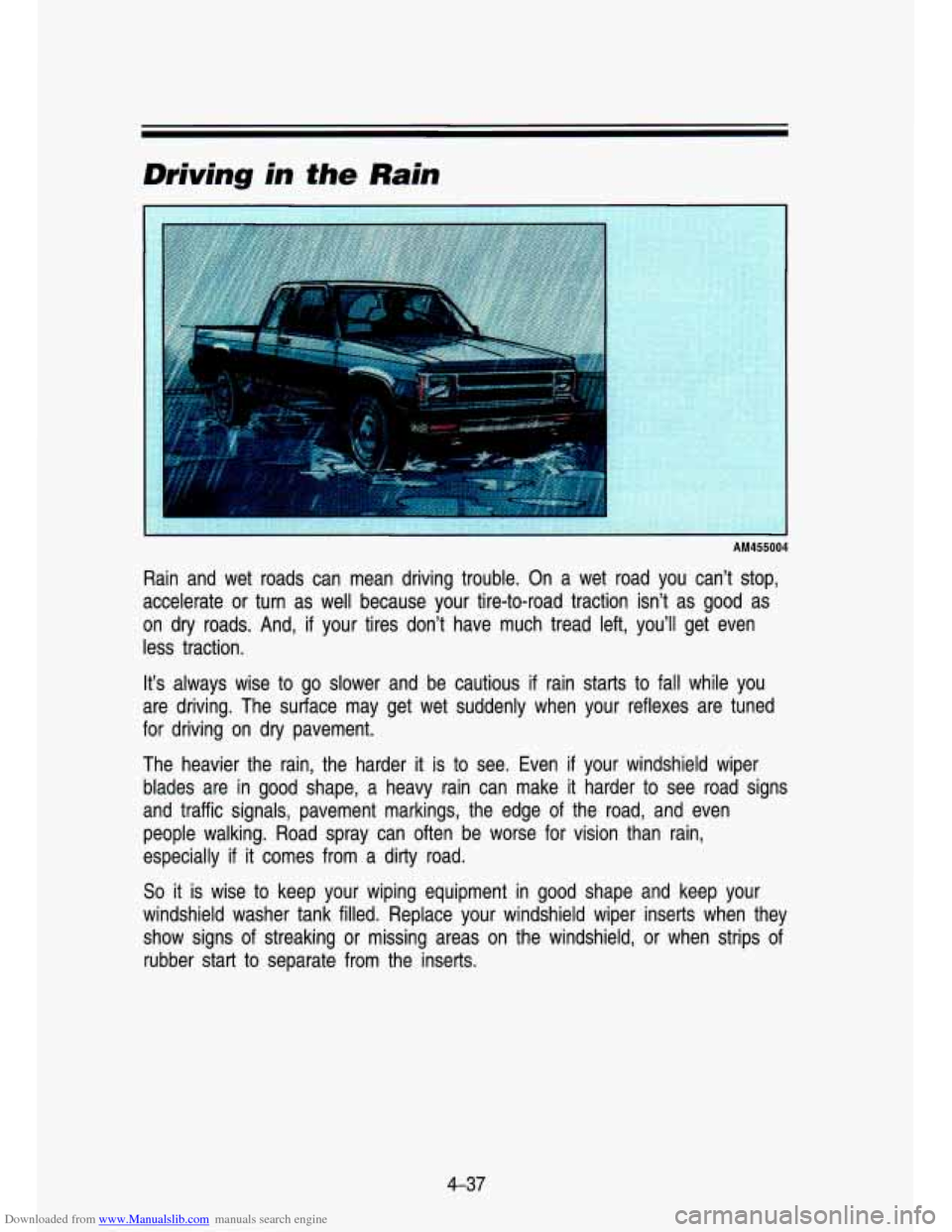
Downloaded from www.Manualslib.com manuals search engine Driving in &ye Rain
I
AM455004
Rain and wet roads can mean driving trouble. On a wet road y\
ou can’t stop,
accelerate or turn as well because your tire-to-road traction isn’t as good as
on dry roads. And,
if your tires don’t have much tread left, you’ll get even
less traction.
It’s always wise to go slower and be cautious
if rain starts to fall while you
are driving. The surface may get wet suddenly when your reflexes are tuned
for driving on dry pavement.
The heavier the rain, the harder it is to see. Even
if your windshield wiper
blades are in good shape, a heavy rain can make it harder to see road signs
and traffic signals, pavement markings, the edge of the road, and even
people walking. Road spray can often be worse for vision than rain,
especially
if it comes from a dirty road.
So it is wise to keep your wiping equipment in good shape and keep your
windshield washer tank filled. Replace your windshield wiper ins\
erts when they show signs of streaking or missing areas on the windshield, or when strips of
rubber start to separate from the inserts.
4-37
Page 193 of 356
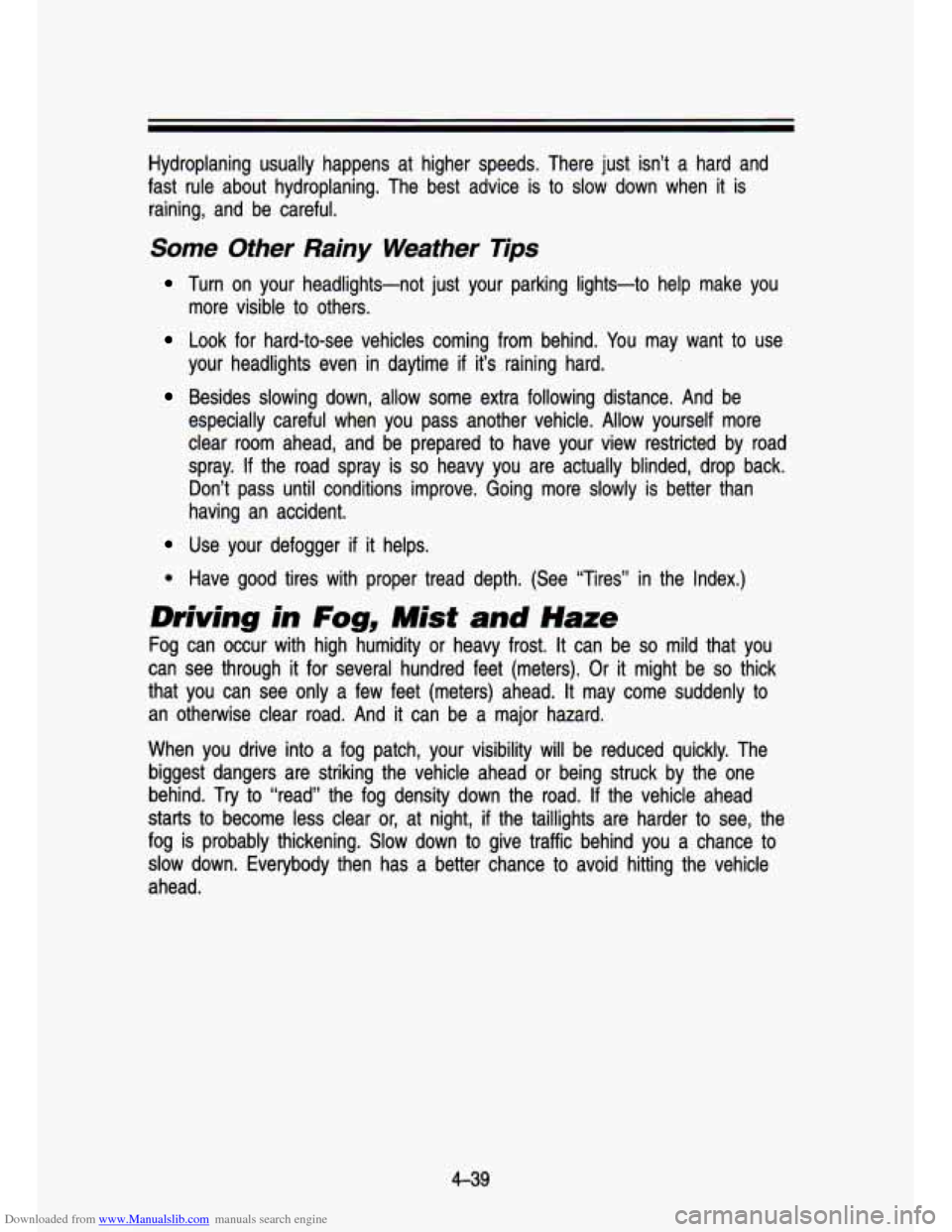
Downloaded from www.Manualslib.com manuals search engine Hydroplaning usually happens at higher speeds, There just isn’\
t a hard and
fast rule about hydroplaning. The best advice is to slow down \
when it is raining, and be careful.
?>me Other Rainy Weather Tips
Turn on your headlights-not just your parking lights-to help ma\
ke you
Look for hard-to-see vehicles coming from behind. You may want to use
more visible to others.
your headlights even in daytime
if it’s raining hard.
Besides slowing down, allow some extra following distance. And \
be
especially careful when you pass another vehicle. Allow yourself\
more
clear room ahead, and be prepared to have your view restricted\
by road
spray.
If the road spray is so heavy you are actually blinded, drop back.
Don’t
pass until conditions improve. Going more slowly is better than
having an accident.
Use your defogger if it helps.
0 Have good tires with proper tread depth. (See “Tires” in the Index.)
Driving in Fog, Mist and Haze
Fog can occur with high humidity or heavy frost. It can be so mild that you
can see through it for several hundred feet (meters). Or it might be
so thick
that you can see only a few feet (meters) ahead.
It may come suddenly to
an otherwise clear road. And it can be a major hazard.
When you drive into a fog patch, your visibility will be redu\
ced quickly. The biggest dangers are striking the vehicle ahead or being struck \
by the one
behind. Try to “read” the fog density down the road.
If the vehicle ahead
starts
to become less clear or, at night, if the taillights are harder to see, the
fog is probably thickening. Slow down
to give traffic behind you a chance to
slow down. Everybody then has a better chance to avoid hitting\
the vehicle
ahead.
Page 194 of 356
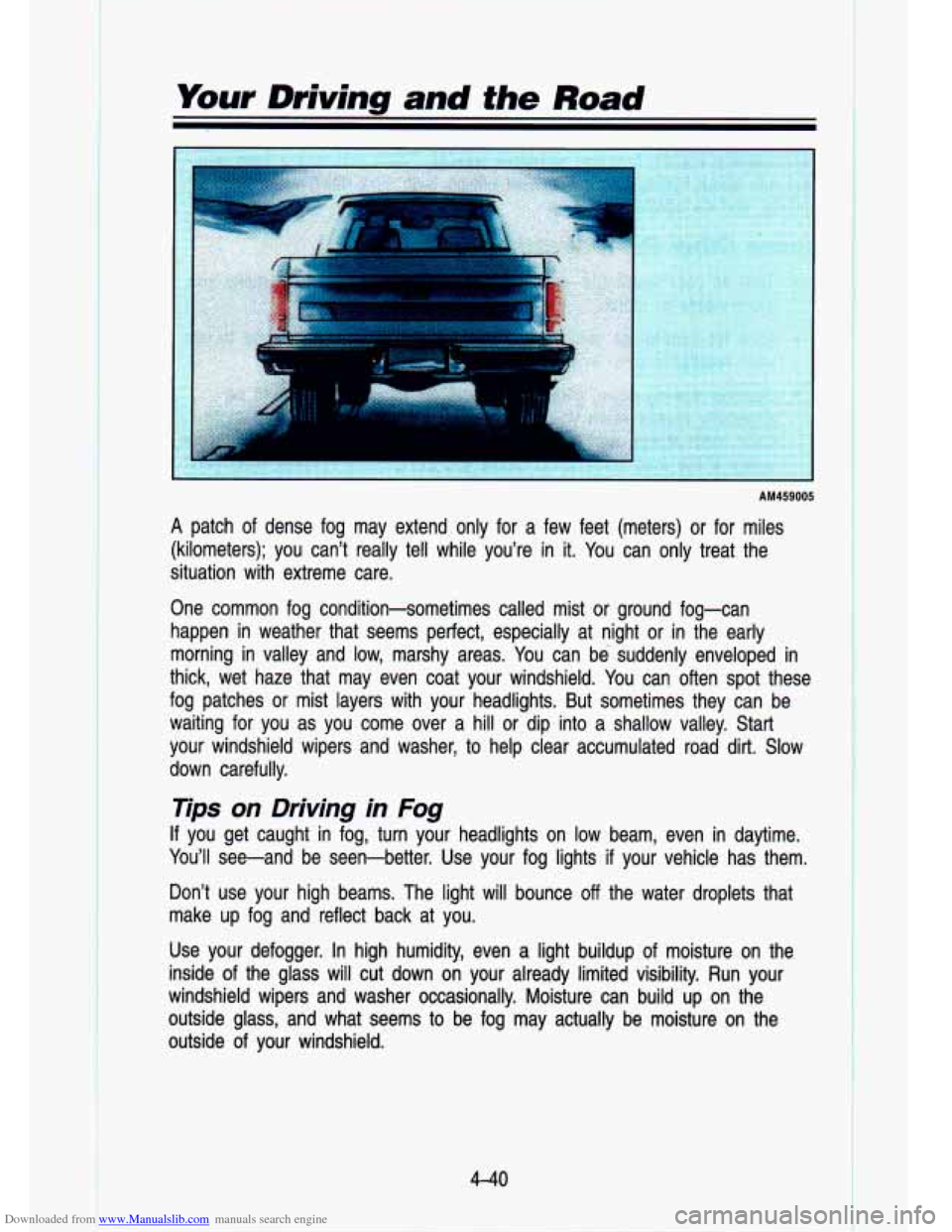
Downloaded from www.Manualslib.com manuals search engine I. Your Driving and the Road
I-
AM459005
A patch of dense fog may extend only for a few feet (meters) or fo\
r miles
(kilometers); you can't really tell while you're in it. You can only treat the
situation with extreme care.
One common fog condition-sometimes called mist or ground fog-can
happen in weather that seems perfect, especially at night or in the early
morning in valley and low, marshy areas. You can be suddenly enveloped in
thick, wet haze that may even coat your windshield. You can o\
ften spot these
fog patches or mist layers with your headlights. But sometimes \
they can be
waiting for you as you come over a hill or dip into a shallow valley. Start
your windshield wipers and washer, to help clear accumulated ro\
ad dirt. Slow down carefully.
Tips on Driving in Fog
If you get caught in fog, turn your headlights on low beam, even in daytime.
You'll see-and be seen-better. Use your fog lights
if your vehicle has them.
Don't use your high beams. The light will bounce
off the water droplets that
make up fog and reflect back at you.
Use your defogger. In high humidity, even a light buildup of moisture on the
inside of the glass will cut down on your already limited visibility. Ru\
n your
windshield wipers and washer occasionally. Moisture can build up\
on the
outside glass, and what seems to be fog may actually be moisture on the
outside of your windshield.
..
_. , .
I t
4-40
R
Page 195 of 356
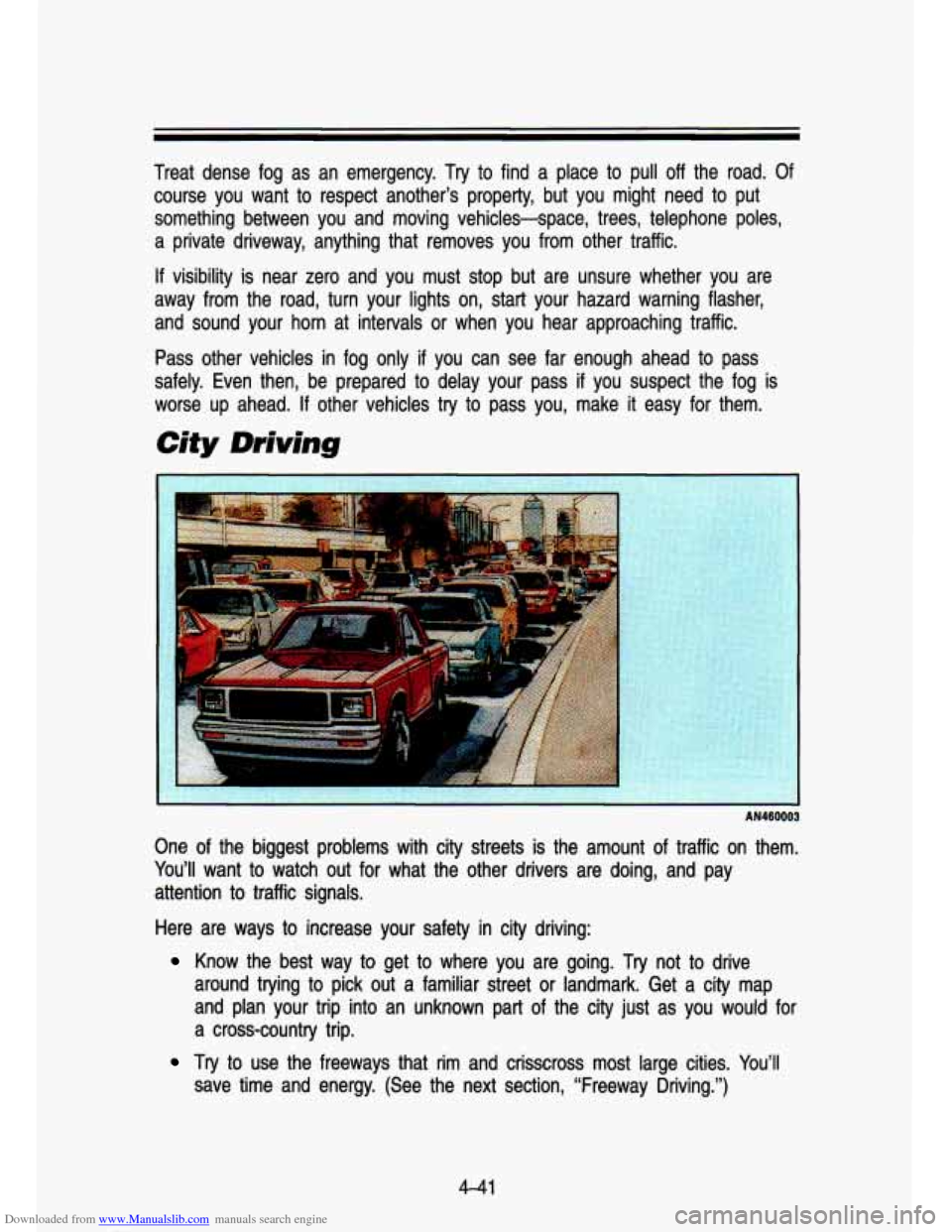
Downloaded from www.Manualslib.com manuals search engine Treat dense fog as an emergency. Try to find a place to pull\
off the road. Of course you want
to respect another’s property, but you might need to put
something between you and moving vehicles-space, trees, telephone\
poles,
a private driveway, anything that removes you from other traffi\
c.
If visibility is near zero and you must stop but are unsure whether you are
away from the road, turn your lights on, start your hazard wa\
rning flasher, and sound your horn at intervals
or when you hear approaching traffic.
Pass other vehicles in fog only
if you can see far enough ahead to pass
safely. Even then, be prepared to delay your pass
if you suspect the fog is
worse up ahead.
If other vehicles try to pass you, make it easy for them.
City Driving
AN460003
One of the biggest problems with city streets is the amount of traffic on them.
You’ll want to watch out for what the other drivers are doing, and pay
attention to traffic signals.
Here are ways
to increase your safety in city driving:
Know the best way to get to where you are going. Try not to drive
around trying
to pick out a familiar street or landmark. Get a city map
and plan your trip into an unknown part of the city just as you would for
a cross-country trip.
Try to use the freeways that rim and crisscross most large cities.\
You’ll
save time and energy. (See the next section, “Freeway Drivi\
ng.”)
4-41
Page 196 of 356

Downloaded from www.Manualslib.com manuals search engine I. - - .. .. Your Driving and the Road
Treat a green light as a warning signal. A traffic light is there because
the corner is busy enough
to need it. When a light turns green, and just
before you start
to move, check both ways for vehicles that have not
cleared the intersection or may be running the red light.
Obey all posted speed limits. But remember that they are for \
ideal road,
weather and visibility conditions. You may need
to drive below the
posted limit in bad weather or when visibility
is especially poor.
Pull to the right (with care) and stop clear of intersections when y\
ou see
or hear emergency vehicles.
Freeway Driving
..
. ~.
3. -. ..
.I
.1 , I- >. -
AN461 003
Mile for mile, freeways (also called thruways, parkways, expres\
sways,
turnpikes, or superhighways) are the safest of all roads. But they have \
their
own special rules.
The most important advice on freeway driving is: Keep up with \
traffic and keep
to the right. Drive at the same speed most of the other drivers are
driving. Too-fast or too-slow driving breaks a smooth traffic f\
low. Treat the left lane on a freeway as a passing lane.
Entering the Freeway
At the entrance there is usually a ramp that leads to the freeway. If you have
a clear view of the freeway as you drive along the entrance ramp, you
should begin
to check traffic. Try to determine where you expect to blend
with the flow.
If traffic is light, you may have no problem. But if it is heavy,
find a gap as you move along the entering lane and time your appr\
oach.
Try
4-42
Page 207 of 356
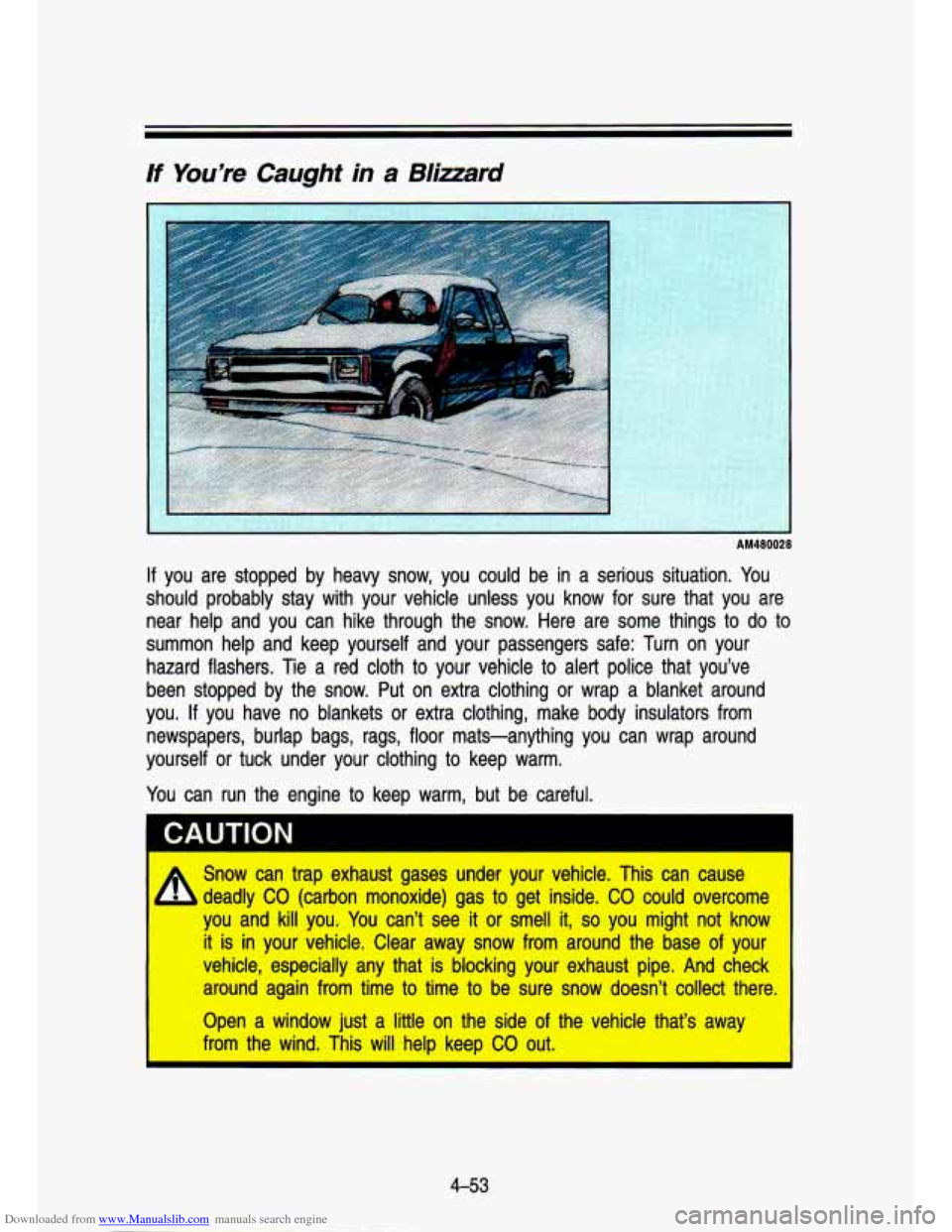
Downloaded from www.Manualslib.com manuals search engine - I- :_
A1480028
If you are stopped by heavy snow, you could be in a serious sit\
uation. You
should probably stay with your vehicle unless you know for sur\
e that you are
near help and you can hike through the snow. Here are some t\
hings to do to
summon help and keep yourself and your passengers safe: Turn o\
n your
hazard flashers. Tie a red cloth to your vehicle to alert police that you’ve
been stopped by the snow. Put on extra clothing or wrap a blanket around
you. If you have no blankets or extra clothing, make body ins\
ulators from newspapers, burlap bags, rags, floor mats-anything you can wrap \
around
yourself or tuck under your clothing to keep warm.
You can run the engine
to keep warm, but be careful.
I
I
Snow can trap exhaust gases under your vehicle. This can cause\
deadly CO (carbon monoxide) gas
to get inside. CO could overcome
you and kill you. You can’t see
it or smell it, so you might not know
it is in your vehicle. Clear away snow from around the base of your
vehicle, especially any that is blocking your exhaust pipe. And check
around again from time to time to be sure snow doesn’t collect there
Open
a window just a little on the side of the vehicle that’s away
from the wind. This will help keep
CO out. I
4-53
Page 213 of 356

Downloaded from www.Manualslib.com manuals search engine Safety Chains
You should always attach chains between your vehicle and your trail\
er. Cross
the safety chains under the tongue of the trailer
so that the tongue will not
drop to the road if
it becomes separated from the hitch. Instructions about
safety chains may be provided by the hitch manufacturer or by the trailer
manufacturer. Follow the manufacturer’s recommendation for atta\
ching safety
chains. Always leave just enough slack
so you can turn with your rig. And,
never allow safety chains to drag on the ground.
Trailer Brakes
If your trailer weighs more than 1,000 pounds (450 kg) loaded, then it needs
its own brakes-and they must be adequate. Be sure to read and follow the
instructions for the trailer brakes to install, adjust and maintain them properly.
And:
Don’t tap into your vehicle’s brake system if the trailer’s brake system
will use more than
0.02 cubic inch (0.3~~) of fluid from your vehicle’s
- master cylinder. If it does, both braking systems won’t work well. You
could even lose your brakes.
Will the trailer brake parts take 3,000 psi (20 650 kPa) of pressure? If
not, the trailer brake system must not be used with your vehi\
cle.
If everything checks out this far, then make the brake fluid tap \
at the
port on the master cylinder that sends fluid to the rear brak\
es. But don’t use copper tubing for this.
If you do, it will bend and finally break off.
Use steel brake tubing.
Driving with a Trailer
Towing a trailer requires a certain amount of experience. Before setti\
ng out
for the open road, you’ll want to get to know your rig. A\
cquaint yourself with
the feel of handling and braking with the added weight
of the trailer. And
always keep in mind that the vehicle you are driving is now a good deal
longer and not nearly
so responsive as your vehicle is by itself.
Before you start, check the trailer hitch and platform, safety \
chains, electrical
connector, lights, tires and mirror adjustment.
If the trailer has electric brakes,
start your vehicle and trailer moving and then apply the trail\
er brake controller
by hand to be sure the brakes are working. This lets you che\
ck your electrical
connection at the same time.
During your trip, check occasionally to be sure that the load \
is secure, and
that the lights and any trailer brakes are still working.
4-59
Page 216 of 356

Downloaded from www.Manualslib.com manuals search engine Your Driving and the Road
2. Let up on the brake pedal.
3. Drive slowly until the trailer is clear of the chocks.
4. Stop and have someone pick up and store the chocks.
Maintenance When Trailer Towing
Your vehicle will need service more often when you’re pulling a \
trailer. See
the Maintenance Schedule for more on this. Things that are esp\
ecially important in trailer operation are automatic transmission fluid (don’t ove\
rfill),
engine oil, axle lubricant, belt, cooling system, and brake adj\
ustment. Each of
these is covered in this manual, and the Index will help you find them
quickly.
If you’re trailering, it’s a good idea to review these sections before
you start your trip.
Check periodically to see that all hitch nuts and bolts are tight.
Trailer Light Wiring
See “Trailer Wiring Harness” in the Index.
Power Winches
If you wish to use a power winch on your vehicle, only use it when your
vehicle is stationary or anchored.
NOTICE
Use the regular brakes, set the parking brake Or UIWK ihe wheels IW keep
your vehicle from rolling.
4-62